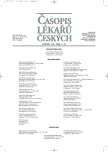-
Medical journals
- Career
Time Perception in Functional Imaging
Authors: R. Jech; P. Dušek; J. Wackermann 1; J. Vymazal 2
Authors‘ workplace: Neurologická klinika 1. LF UK a VFN, Praha ; Institut für Grenzgebiete der Psychologie und Psychohygiene, Freiburg i. Br., Německo 1; Nemocnice Na Homolce, Praha 2
Published in: Čas. Lék. čes. 2005; 144: 678-684
Category: Original Article
Overview
Background.
Knowledge of physiological mechanisms underlying time perception is still rather limited. The aim of our study was to search for a ‘time accumulator’, i.e. the part of the brain where information on the duration of time is stored.Methods and results.
Nine healthy volunteers were given a time reproduction task during event-related fMRI. Subjects were instructed to retain the duration of the stimulus presented (presentation phase) and then to reproduce it by pressing a button (reproduction phase). Two different analyses were made: event-related (P<0.05, FWR corrected) and parametric (BOLD signal increase/decrease during the presentation/reproduction phases correlated with the time intervals; P<0.01, FDR corrected). When the event-related approach was employed, activation was noted bilaterally in the inferior prefrontal cortex (IPFC), supplementary motor area (SMA), precuneus and secondary visual cortex. On the right, there was activation in the dorsolateral prefrontal cortex (DLPFC), gyrus cinguli and inferior parietal lobule. On the left, the primary sensory-motor cortex was activated. While during the presentation phase the left DLPFC activity inversely correlated with the presented duration, a nearly identical area showed positive correlation in the reproduction phase.Conclusions.
The event-related analysis did not allow distinguishing the process of time perception from many cognitive processes running simultaneously. In turn, the parametric analysis was based on visualizing regions, in which the signal correlated with the varying duration of the time interval provided the level of attention, decisionmaking and the processes of behavioral response planning and execution were constant. Moreover, the right and left DLPFC seem to play different roles in time perception. While the left one is functioning as a „time accumulator”, the right one is rather involved in the recognition of previously perceived intervals.Key words:
time perception, time reproduction, working memory, prefrontal cortex.
Labels
Addictology Allergology and clinical immunology Angiology Audiology Clinical biochemistry Dermatology & STDs Paediatric gastroenterology Paediatric surgery Paediatric cardiology Paediatric neurology Paediatric ENT Paediatric psychiatry Paediatric rheumatology Diabetology Pharmacy Vascular surgery Pain management Dental Hygienist
Article was published inJournal of Czech Physicians

-
All articles in this issue
- Periodic Limb Movements in Sleep: Polysomnographic and Actigraphic Methods for Their Detection
- Alternating Hemiplegia of Childhood (AHC)
- Embolism of the Upper Mesenteric Artery
- Treatment of Juvenile Pemphigus Vulgaris with Intravenous Immunoglobulins
- Alcohol and Pregnancy
- How Many Pathological Gamblers is in the Czech Republic
- A Hitherto Unknown Priority of Jan Ev. Purkyně – Myocardial Sleeves of the Pulmonary Veins. Contribution to the Pathogenesis of Atrial Fibrillation
- Purkyně´s Concept of Neuron
- Future Possibilities of the Multiple Sclerosis Treatment
- Aging Eye – Its Specific Features and Diseases
- Lung Cancer Operability – History and Presence
- Intermittent Catheterization of Urinary Bladder – Indications, Technique, Complications
- Time Perception in Functional Imaging
- Heart Rate Variability During Sleep
- Journal of Czech Physicians
- Journal archive
- Current issue
- Online only
- About the journal
Most read in this issue- Heart Rate Variability During Sleep
- Alternating Hemiplegia of Childhood (AHC)
- Intermittent Catheterization of Urinary Bladder – Indications, Technique, Complications
- Alcohol and Pregnancy
Login#ADS_BOTTOM_SCRIPTS#Forgotten passwordEnter the email address that you registered with. We will send you instructions on how to set a new password.
- Career

